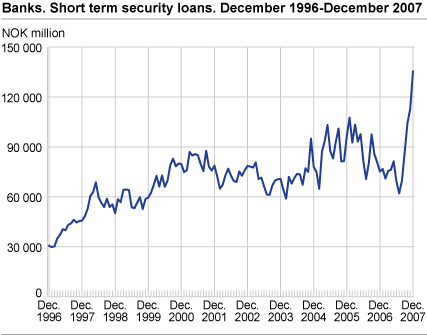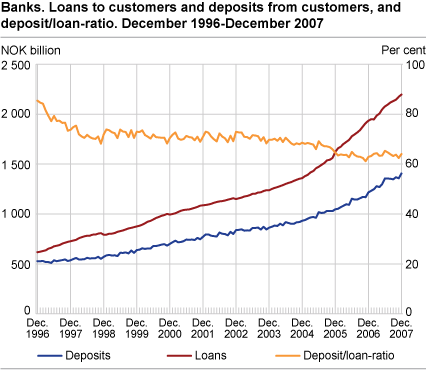Content
Published:
This is an archived release.
Sharp increase in short-term security loans
From November to December last year, banks’ short term security loans increased by nearly NOK 23 billion. The sharp increase is mainly ascribed to the troubles in the credit and liquidity market in the second half of 2007.
Banks finance their operations from different credit sources. The two most important long-term credit sources are customer deposits and bond loans. Customer deposits are usually regarded as the safest, least expensive and most stable of these sources. Alternatively, the banks can finance their operations from short-term credit sources in the money market, such as security loans, inter-bank loans and loans in the central bank.
Increase in deposit/loan ratio and decrease in bond loans in December
In December 1996, the banks’ deposit/loan ratio was 85 per cent, which means that 85 per cent of their loans were financed by deposits. In December last year, the ratio was 64 per cent, a 21 percentage points decrease from 1996, but an increase of 2 percentage points from the previous month. Both the deposit/loan ratio on loans to non-financial corporations and households increased, amounting to 71 and 51 per cent respectively. This represents an increase of nearly 3 percentage points for loans to non-financial corporations and 1 percentage point for household loans from November 2007. The banks’ bond loans amounted to NOK 476 billion at end-December 2007. This is a decrease of more than NOK 8 billion from the previous month.
Increase in security loans caused by international financial turmoil
Borrowing in the money market is normally regarded as less propitious than borrowing in the market for long-term credit sources. One reason for this is that the banks’ loans to customers normally have longer maturity than loans in the money market. To reduce risk exposure, it may be an advantage to have a more equal maturity on lending and funding. However, the troubles in the credit and liquidity market in the second half of 2007 resulted in long-term financing from bond loans becoming more expensive. Figures for December imply that many banks had no choice but to finance their operations from short-term security loans instead of bond loans. Banks’ short-term security loans amounted to NOK 135 billion at end-December 2007. This represents an increase of nearly NOK 23 billion compared to November 2007 and NOK 60 billion from December 2006. Loans from Norges Bank also increased in December 2007, by more than NOK 11 billion compared to November 2007. Inter-bank loans, however, decreased by nearly NOK 12 billion, but it should be noted that November 2007 was an all time high. Banks’ inter-bank loans amounted to NOK 571 billion at end-December 2007, the second highest level ever.
The statistics is now published as Banks and mortgage companies.
Contact
-
Statistics Norway's Information Centre
E-mail: informasjon@ssb.no
tel.: (+47) 21 09 46 42


